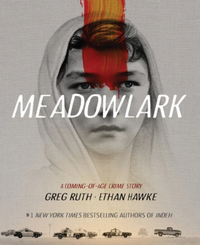 |
Meadowlark:
|

What’s Meadowlark About?
Things aren’t going well for Cooper—a little prank leads his father to stop by his mother’s house on his way to work. When his father learns that Cooper’s been expelled from school, he drags him along with him to work.
Cooper’s dad, Jack “Meadowlark” Jackson used to be a boxer of some local renown, but that was then. He’s now a prison guard—one respected by his peers and even most prisoners. But Cooper still thinks of him largely as a hero figure. the boxer whose poster hangs on his bedroom wall.
While Jack gets to work in a prison tower, Cooper hangs out with the Warden—clearly a grandmotherly figure in his life. It seems like a pretty okay kind of day, actually. And then an alarm sounds. Several fights have broken out in various parts of the prison—the guards spread out to imposing order, and in the midst of chaos, three prisoners go missing.
It’s after this that things really start to go south.
The book then focuses on Cooper and Jack trying to make their way through the ensuing bedlam while they deal with their relationship. Being the father of a teen boy brings a certain level of difficulty, especially if there’s trouble between the custodial mother and the father. The violence—horrible violence—of the day creates a heightened atmosphere for their necessary (and rather touching) conversations.
What about the Art?
You can’t talk about a graphic novel without focusing on the graphic part of it, right? Which is really a shame because I’m not equipped for it.
Ruth’s art is exactly what this story needs—as usual, I don’t know how to describe the art, but the pencil work—sort of rough and heavy—fits both the action and the characters. The sort of sepia-coloring says Texas to me—and makes the setting ring true.
I did appreciate the not-at-all-subtle use of Ethan Hawke as Jack, it added a little extra flavor.
So, what did I think about Meadowlark?
This seems like the kind of story that S. A. Cosby or Jordan Harper would write—a mix of family drama and crime.
The emotions and family dynamic felt real, relatable—and was even touching. The violence and criminal behavior were just as visceral—and disturbing. You put them together with some compelling artwork and you’ve got yourself a winner.
I’d have liked a touch more depth—but given the medium, I’m not sure you could get too much deeper (without needing another hundred pages or so)—so I’m not holding that against it too much.
There’s a lot to commend in this graphic novel, and very little to complain about. I see that Hawke and Ruth have collaborated on an earlier graphic novel and I need to track that down.
This post contains an affiliate link. If you purchase from it, I will get a small commission at no additional cost to you. As always, opinions are my own.
![]()





